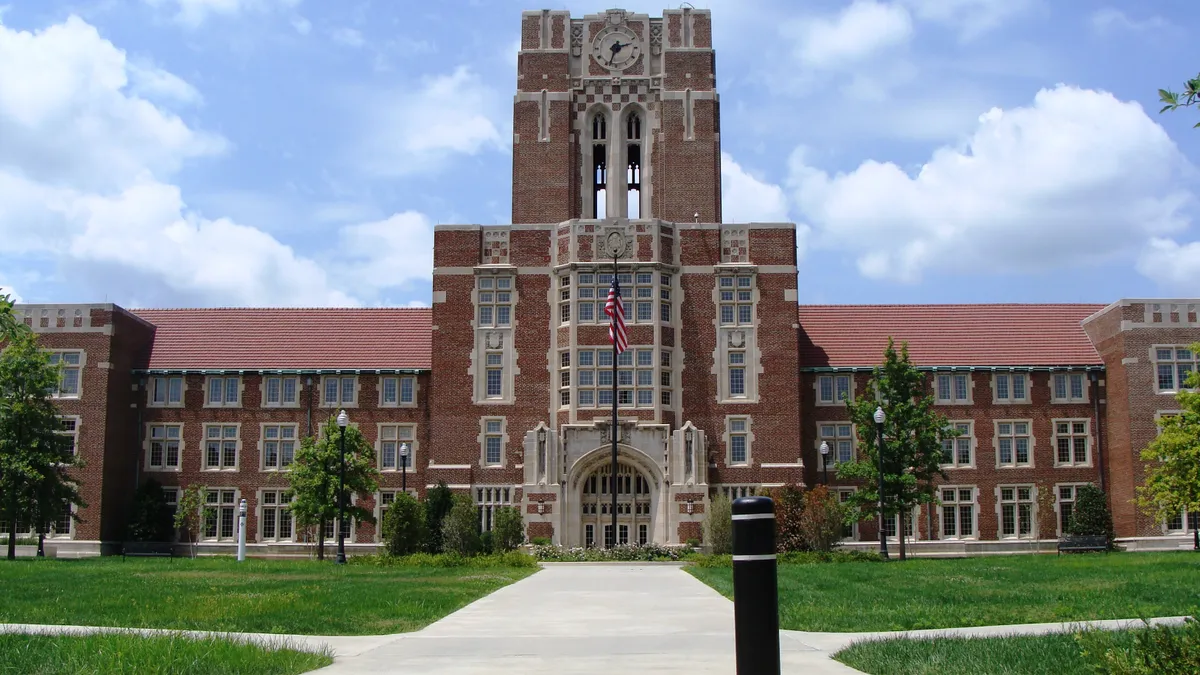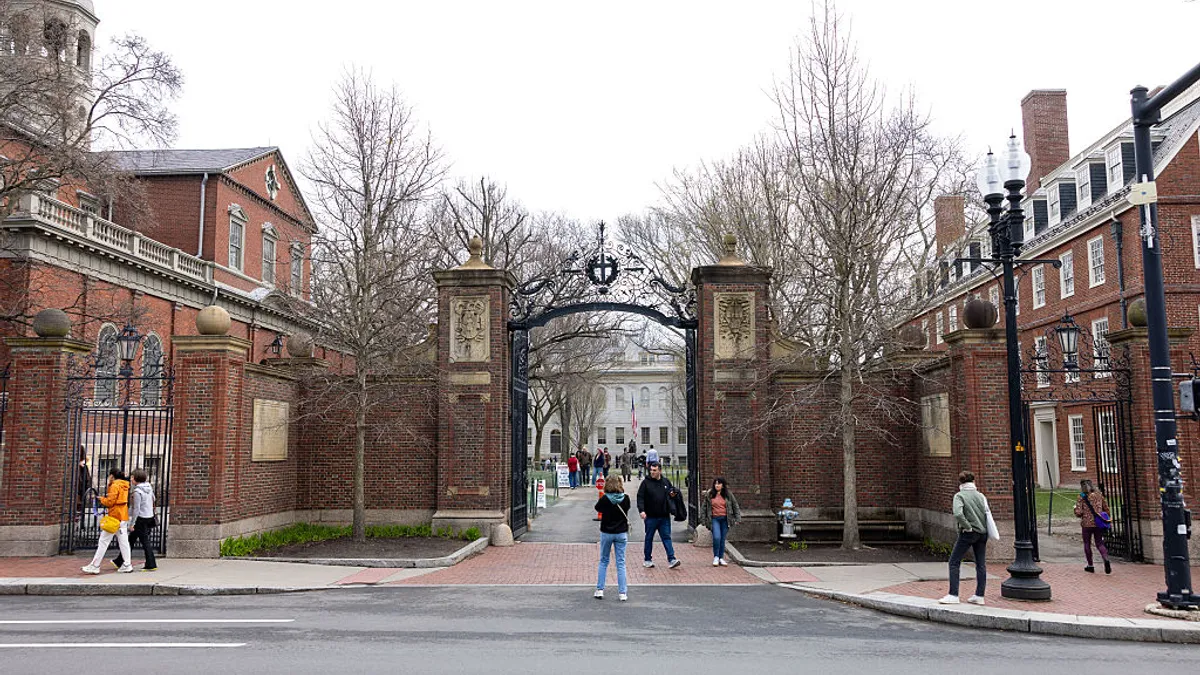Free college is in the spotlight as the country looks to stem the growth of rising higher education costs. Around half of states offer their residents some form of "promise" program, and some 300 local programs guarantee students tuition-free college at public, and sometimes even private, institutions.
Yet for all the momentum behind the movement, little is known about its long-term impact on college enrollment. Even less is understood about how it will affect four-year public universities.
Early reports from Tennessee and Oregon — two states with some of the longest-running free college plans — show such programs' first year can lead to lower enrollment at state four-year schools. But that effect seems to flatten out almost entirely by the second year.
Trying to tie up a wide swath of programs with one bow is hard to accomplish, however. Expanded access to free community college across California has stressed many of its four-year institutions. That's caused California State University, Fresno (Fresno State) to dramatically raise the bar for acceptance. Meanwhile, officials at the University of Tennessee (top image) were so impressed with the state's promise program successes that the system is rolling out its version of the program in the fall of 2020.
"I'm not sure we know the [impact of these programs] with rigorous studies yet," said Beth Akers, senior fellow with the Manhattan Institute.
Although the impact of free college on four-year institutions is uncertain, their enrollment levels are already threatened by other factors, said Martha Kanter, executive director of the College Promise Campaign. With some estimates predicting a decrease in the number of high school graduates ahead, she said, "If you are a college or university state-funded based on enrollment, you’re going to be scrambling."
Schools don't only need to change how they recruit students, taking into account both adult learners and promise program students, Kanter said. They also must revamp services to meet these students' varying needs, such as offering babysitting for adult learners' children and counseling for transfer students.
"The historic complaint is, 'They're taking my students,'" she said. "Frankly, those days are over. There are too many people who aren't getting the education they need."
Tennessee's transition
Tennessee makes the best test case for determining how free college programs will affect four-year state schools, in part due to the longevity of its effort. But even there, data continues to shift.
In 2015, it launched the first statewide free college program for high school graduates, later amending it to include adult learners. The program quickly met its goal of increasing the percentage of state residents attending some form of postsecondary education. In the first year, 57,660 high school seniors applied for the program; since then, that number has risen to 64,420 for the most recent cohort. Statewide, the college-going rate increased from nearly 59% to 64%.
The impact on the state's four-year university system appears minimal.
In the fall of 2015, the first year the program was in place, the University of Tennessee saw its incoming student body decrease 5.5% year-over-year from 7,977 students to 7,541 students. However, by the fall of 2017, its incoming freshman class had swelled to 8,029, a modest increase over the 2014 numbers and 6.5% higher than 2015's enrollment.
Oregon, which began its statewide program a year after Tennessee's, saw similar results. Community college enrollment increased 4.2 percentage points in its first year while four-year schools' enrollment dropped 2.9 percentage points, according to a 2019 study. By the second year, the community college surge remained while four-year schools were no longer losing enrollment.
It's hard to know all the factors that affect enrollment, said Jennifer Mishory, senior fellow at The Century Foundation. A recession can increase the number of students attending community colleges, resulting in natural attrition as the market strengthens, she added. The change could also be due to population increases in some states, like California, while other states are losing residents.
What is known is that many students seek to continue their education after they enter a free college program.
In Tennessee, 25.6% of the first cohort of students transferred to another community college as of the summer of 2018; 21% went to public universities and 11.7% opted for private institutions.
Nationally, 29% of community college students transferred to four-year institutions within six years, according to data compiled by the Community College Research Center.
Building in transfer pathways
The University of Tennessee has taken several steps to accommodate its new crop of transfer students, said Fabrizio D'Aloisio, its director of undergraduate admissions.
That includes creating the Volunteer Bridge Program, which lets students taking classes at Pellissippi State Community College live on the university's campus and access most of its student services. Students are guaranteed admission to the University of Tennessee when they complete Pellissippi's program, which covers their freshman year.
The university also created an undergraduate transfer center in its admissions office to help all promise program students make the change smoothly.
In California, the interplay between the state's free community college program and the 23 four-year schools in the California State University system is different.
All state schools were mostly free to residents until the 1960s, when the state enacted a master plan and started pushing up in-state tuition and fees. But even today, a full-time community college student only pays around $1,100 a year in tuition for two, 12-credit semesters; Cal State campuses cost $6,744 a year for in-state residents.
An uptick in the number of opportunities for free community college in California caused an increase in transfer applications to Fresno State, prompting it to raise admissions standards for those students, said Malisa Lee, the university's associate vice president for enrollment management.
"It's a conversation we keep having," she said. "There's not enough funding to take all the students we want." Fresno State gets 90% of its 24,000 students from four counties in the state's 450-mile-long Central Valley — a region that grows a quarter of the food consumed in the U.S.
While the school typically takes 1,900 transfer students, a surge in interest has pushed up its requirements. A decade ago, the school accepted community college transfers with a 2.0 GPA, Lee said. Now, students need a 2.9 GPA for admission. And because 70% of the transfer students don't apply to other schools, she said, "If you have a 2.8 now, you go into the workforce, and chances are you don't return for your bachelor's."
Lee said the university hopes more funding and a higher percentage of students graduating within four years will open up more spots in the coming years.
"The historic complaint is, 'They're taking my students.' Frankly, those days are over. There are too many people who aren't getting the education they need."

Martha Kanter
Executive director, College Promise Campaign
In the meantime, California's surplus of students has become a target for recruiters at out-of-state colleges. "My team has some concern about that," Lee said, wary that declines in high school enrollment might eventually whittle away the region's supply of students.
But even with all the momentum for promise programs, sources interviewed for this story predicted a national plan would be hard to implement, even if free college supporters such as Democratic Sens. Bernie Sanders or Elizabeth Warren won the 2020 election. And that type of caution could serve the movement well.
"To me, it makes sense to watch and see what's happening in the states as they implement these plans," Akers said. "We're learning a lot about what could happen."





















